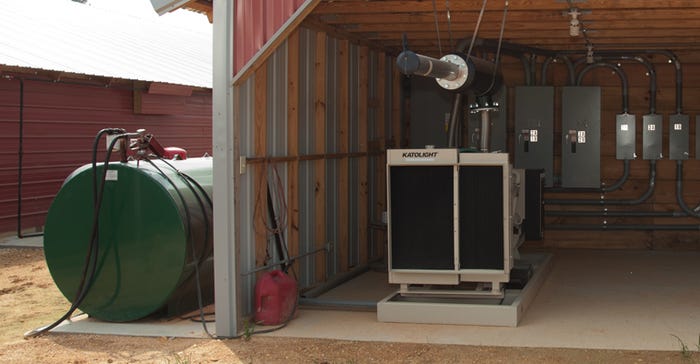For reliable back-up power, schedule generator maintenance and have operating procedures in place.
September 16, 2019

Sponsored Content
Our modern production facilities rely on electrical power to maintain their environmental, feeding and watering systems. Every year losses occur because the generator fails to supply service during a power outage. To avoid generator malfunctions, livestock producers should establish a routine maintenance program for farm generators.
Weekly maintenance
1) Monitor the generator's automatic run cycle, verifying the unit ran without alarms or warnings.
2) Confirm the unit is in "auto" mode.
3) Visually check for fuel leaks.
4) Ensure the circuit breaker is closed.
5) Check fuel level.
Monthly maintenance
1) Check the battery charger.
2) Check engine oil level.
3) Check coolant levels.
Yearly maintenance (with a certified technician)
Manufacturers may have a more expanded list, but at minimum, the annual maintenance should include the following items:
1) Change the oil and filter.
2) Change the fuel filter.
3) Change the battery (every two years).
4) Check the exhaust system.
5) Inspect the wiring.
6) Inspect the belts.
7) Change the spark plugs.
8) Check electrical breakers, replace if suspect.
9) Check cooling system and hoses. Stock coolant and spare hoses.
10) Perform load bank testing. (Artificial load placed on the generator verifying it's performing at full capacity. Helpful in pinpointing any weak components.)
Farm management may also consider entering into an annual service contract with their generator supplier. Along with the scheduled maintenance program, a typical agreement provides for on-site emergency service calls.
Every farm should have a load management plan in place to balance the generator output with the electrical loads. In many cases, the generator is not sized to run the farm's electrical system at full capacity. A load management plan details which equipment should be activated when the farm is operating on emergency power. For example, the plan could call for shutting off the tunnel fans in a gestation/breeding building and lowering the curtains for ventilation. While in the farrowing house, the fans would continue to operate, but half the heat lamps would be switched off.
Even with a generator sized to power the entire facility, it is prudent not to tax the system to capacity. Check the running load and if in doubt, take any unnecessary equipment offline to provide a margin of error. Just assuming the generator is capable of running the entire facility is risky. It is crucial to monitor and manage an operating generator.
Responsible operation of a generator means monitoring the amount of available fuel. Instead of relying on a sight gauge, use a simple fuel dipstick. Make one from 3/4inch wooden dowel rod designated with 1/4, 1/2, 3/4 and FULL marks. Insert the dipstick into the tank and visually check the fuel level. Also, post the expected run time for each fuel level near the generator. The operator can then estimate how long the facility will stay powered according to the current fuel level.

After generator startup, the farm manager should verify the amount of fuel in the supply tank. Don't assume there is adequate fuel and leave the farm, only to find out later the generator ran out of fuel several hours later. The operator should continue to check the fuel level noting any variations from the estimated run times. Powering the farm during weather extremes, such as operating large fans in the summer or heating systems in the winter, can easily cause the generator to use more fuel than estimated.
Remember a facility running on standby power has no fallback position. Performing routine generator maintenance and detailing an operating plan helps to ensure the health and well being of our animals during power outages.
About the Author(s)
You May Also Like


